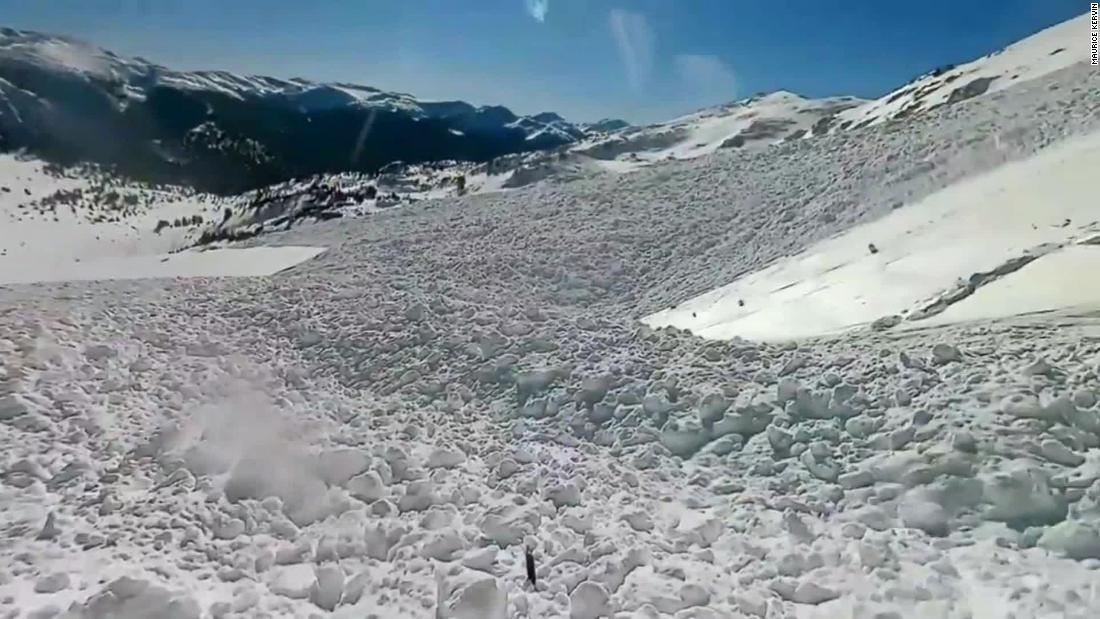(CNN) – Less than a minute after descending the slopes of Colorado’s interior, a snowboarder was swept away by an avalanche.
Maurice Kervin was snowboarding on January 8 at No Name Peak, near Loveland Pass in Summit County, when he turned to see snow coming at him, he said.
“I was amazed at how big it was and very grateful to be alive, honestly, or not buried, not wounded to death,” Kervin told CNN. “The magnitude of that was definitely enough to bury, maim or possibly kill him. It was very intense.”
Avalanches are unpredictable and dangerous, and not every story has a good ending like Kervin’s.
‘Shooting slits’ formed like cobwebs in the snow
Kervin said he realized something was wrong when he saw “cracks” below him.
“The snow is breaking into blocks, essentially, and it looks like cracks or cobwebs are breaking in front of you in the snow,” he said.
When the snow started to drag him down, Kervin said he used his airbag backpack to keep him on top of the snow.
The air blew, sounding like there was a lot of air pressure being released at once, as heard in the video. Snow was hurled at him and around him when he fell about 300 meters.
“I dropped my ax and my camera on my back and pulled out my airbag, which helped me float on the snow,” said Kervin. “I managed to get my feet above the snow after falling off a small cliff and was able to float on top of the snow until it stopped.”
As soon as he stopped, the world “was still moving around me,” he said. “It was very surreal at the time.”
“I’m fine. I’m fine. I’m fine. I’m fine. I’m clean. I’m safe. I’m safe,” Kervin said in the video after resting.
Kervin, a cryptocurrency investor and amateur snowboarder, said he knew the conditions for a risky run, but said he spent time checking snow conditions as he and a friend walked three kilometers to the peak. They felt confident to make their run.
“As anyone who has been caught in an avalanche can tell, we thought we were free and decided it was an attempt, and it clearly wasn’t,” he said.
Kervin called 911 and learned that a search and rescue operation had already started, he said.
90% of avalanches are caused by humans
Two people were caught in avalanches that day and both were caused by humans, CAIC director Ethan Greene told CNN. Kervin started one of them, he said.
“About 90% of the accidents we have happen when someone dies or someone in their group causes the avalanche, rather than a natural avalanche that hits someone,” he said.
It is very common for a human to trigger an avalanche. So far this year, Colorado has had an above-average number of avalanches, Greene said.
CAIC has registered 259 avalanches in Colorado so far this year, on Saturday night, Greene said.
“In Colorado, we register about 4,000 avalanches a year. Getting almost 300 over a two-week period is a lot, but not uncommon,” he said. “Because of the snow accumulated this year, we have seen more avalanches triggered by humans than normal.”
Greene said it is easy to trigger an avalanche, but it is possible to avoid areas that could be dangerous. It just takes some training and planning.
“What I want to tell people is what they should do is check the forecast before going to the hinterland, so that they can make a plan for the day that is appropriate to the conditions,” he said. “Getting a little training can also save your lives.”
“After the snow passes in an avalanche, it becomes very hard, almost like concrete,” he said. “You won’t be able to dig yourself up. The snow is so hard that you will need someone else’s help.”
Kervin, who has been skiing since the age of 4 or 5, suggests always going with a companion or group of people when skiing.
He expects people to see what happened in his video and receive the proper education, equipment and people to go with them before going to the hinterland, he said.
“I will not tolerate anyone who tries to do what I did. That is my personal choice,” he said. “Be safe in the hinterland and understand the risk assessment and your position.”
